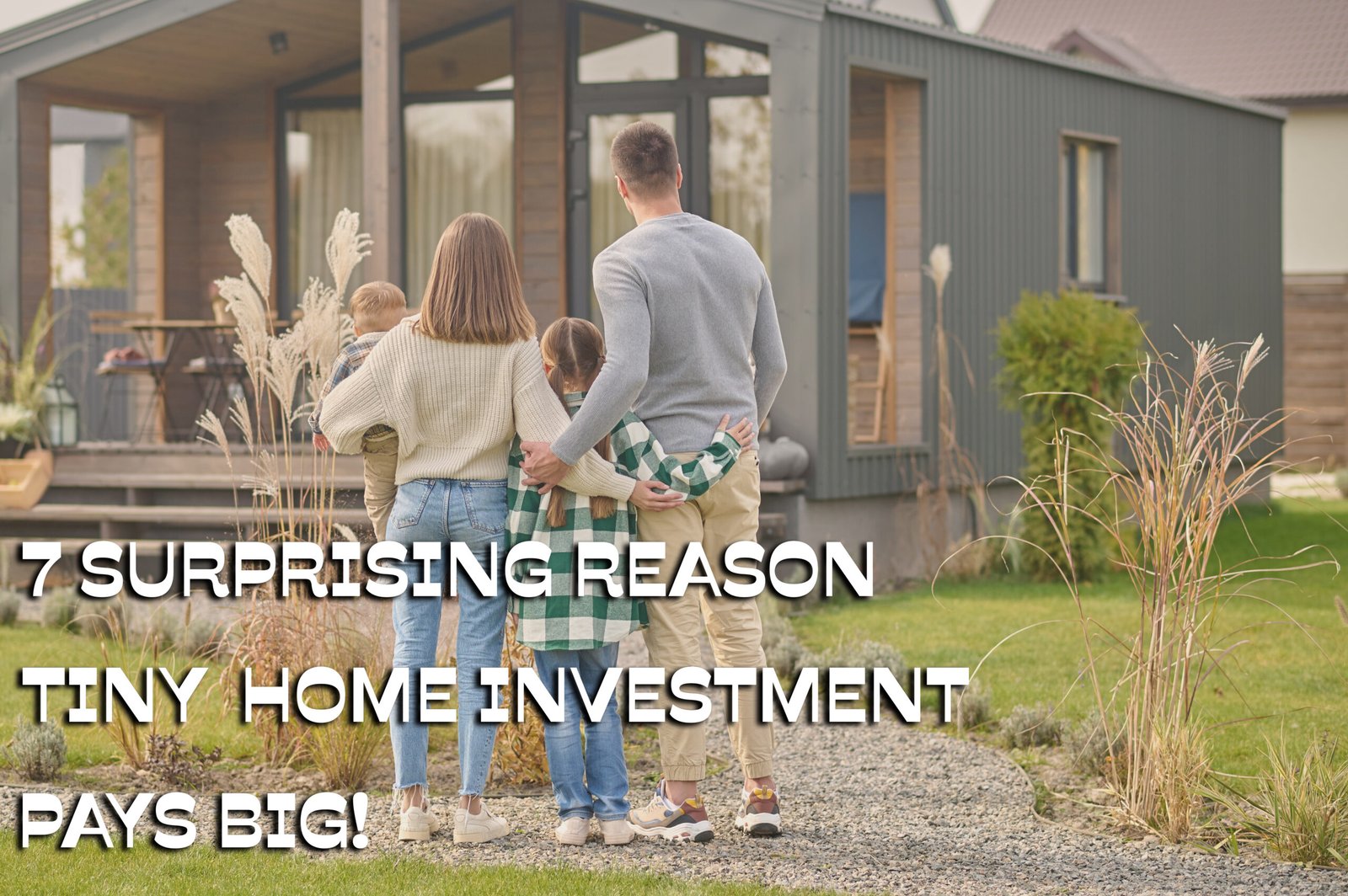Uncover 7 surprising reasons why tiny home investing pays big. Learn how this smart, low-cost strategy can boost returns and unlock long-term financial freedom.
The Rise of Small Home Investments
Tiny houses have grown from being an ultralife fad to being an independent investment strategy. Housing prices are still on the rise, and increasingly, individuals are opting for small but cost-effective alternatives for traditional living. The tiny houses, typically taking up 100 to 400 square feet of space, not only save the environment but are also cheap to build and maintain. For the investor, it is a great way to invest in an expanding trend of more affordable and efficient housing.
The market for tiny homes is being fueled by a range of diverse consumers. The student with student loan debt, the retiree who has been pushed into downsizing, and the green consumer are all key drivers of demand. Affordability of the small homes allows such consumers to become homeowners without having enormous mortgages. Second, the flexibility of where small homes may be situated—on single-family land, in small home subdivisions, or as ADUs—is more appealing to more consumers.
Technology and vacation rental sites have further increased the profitability of small homes. With the choice of renting through Airbnb or Vrbo, investors are now receiving simply fantastic returns in the way of rental income, especially for locations with high tourist traffic. One well-decorated mini-house in a high-end tourist hub will receive as much, if not even more, than the average apartment rental. These are some of the phenomena that have made tiny home resorts, glamping resorts, and eco-friendly lodges possible, and in doing so have transformed the very concept of alternative housing.
Furthermore, the cultural movement towards sustainability and minimalism is the same values that tiny home living represents. As people increasingly take responsibility for their own carbon footprint and attempt to live more simply, tiny homes represent the real-life solution. Value-driven demand is not a fleeting phenomenon—rather, it is a long-term cultural sea change that makes tiny homes a very real and nascent asset class in real estate.
In most cases, investment in tiny homes is a concept of tiny houses and not a case of house size. It is a mindset shift when it comes to housing, mobility, and life. Early inclusion for micro-home investors can be a matter of convincing profit as well as a stake in redefining the future of sustainable living.
Why Tiny Homes Investing Delivers Big Returns
Tiny homes provide high returns mainly because they have low overhead expenses but high potential returns. In comparison to conventional property, the cost of purchasing or constructing a tiny home is much lower, typically falling in the range of $30,000 to $80,000. The lower amount of investment means that investors get positive cash flows at an earlier point, even after a year or two. The lesser financial barrier also makes diversification easier and quicker to recover.
These kinds of houses are also popular on short-term vacation rental websites. Tourists and travelers are now looking for unique, Instagrammable getaways, and tiny houses fit the ticket exactly. A treehouse-style tiny house in the woods or a very contemporary one in the mountains, these kinds of houses are bringing in the big nightly rates. The operators of these homes who succeed can earn more than $3,000 a month, based on where they are and what time of year it is—much more than they would earn from similarly priced traditional rentals.
In addition to rent money, tiny homes are easy and efficient to maintain. They can be placed in backyards as a straightforward guest house, used as vacation homes, or placed in specially designed tiny home villages. Other investors buy multiple units and create small residential clusters that are scalable rental operations. Others install solar panels or off-grid facilities in efforts to increase marketability and lower expenses. Such flexibility produces numerous different avenues for ROI depending on what the investor is trying to accomplish and the health of the existing market.
Furthermore, the regular shortage of housing in most jurisdictions renders tiny homes an opportune solution. High-demand, low-supply municipalities are resorting to ADUs and alternative structures overall in order to bridge the gap. By offering a regulatory- and budget-friendly solution, tiny homes answer both neighborhood and municipal needs. Such broad regulatory support in some areas also makes them a long-term investment option.
Finally, micro houses aren’t a trend-they’re a smart reaction to changing demographics, lifestyles, and economies. Those who observe this phenomenon and join this bandwagon can reap huge rewards from these footprint-low houses.
1. Low Building and Maintenance Expense
Mini houses are less expensive to construct compared to regular houses, at times even half the cost. Small, they consume less material, fewer laborers, and less maintenance—amazing ROI when rented out or resold.
2. High Rental Demand in Niche Markets
Visitors, students, telecommuters, and minimalists all increasingly desire short or extended periods of rented small homes. Growing demand enables owners to attain a consistent rate of occupancy and equivalent rents, particularly on a site like Airbnb.
3. Land Flexibility for Placement
Small houses can be easily fitted on small ground lots, potential land, or even small home communities. This is cost-effective in land purchasing and enables investors to gain entry into several local markets with less expense.
4. Reduced Break-Even Times
Due to relatively smaller initial capital and rental yield being retained, investors can regain their capital much earlier than in conventional property investment, enhancing their efficiency in the cash flow aspect.
Groß-Based Instruction:
5. Eco-Friendly Appeal Generates Value
Going green generates value for the property. Greenhouse-conscious tenants will pay a premium for tiny houses with solar, greywater, or off-grid provisions, boosting profitability.
6. Sources of Funding Have Become Seamless
With the continued evolution of the tiny home industry, alternative lenders and other credit unions provide niche finance options. This lowers the entrance barrier for new investors and speeds up purchases of properties with good repayment conditions.
7. Portfolio Diversification and Scalability
It is easy for investors to build a portfolio of small homes as they are inexpensive and take up minimal space. It facilitates diversification in several markets with minimal market reliance within one market.
8. Relief and Tax Allowances
Dependent on whether the mini-home is to be occupied as one residence or residential rental, investors qualify for tax allowances on insurance, interest, maintenance, or depreciation, providing aggregate returns long term.
9. Good Resale Market for Custom-Built
Everyone desires turnkey, professionally constructed mini-homes, especially intelligent ones. Resale will be simple and highly profitable if functionality and construction are desirable and ready to occupy.
10. Positive Market Growth Outlook
The tiny house market will incrementally increase year by year because of the lack of urban housing and unaffordability. Early investment will place the investor in a position for ultimate growth and appreciation.
Risks to Consider Before Tiny Home Investing
As wonderful as the opportunity for profit is, so too is investing in tiny houses risky in its own right to thoroughly consider. Regulating and zoning top the list, naturally. The majority of cities tightly regulate where small houses must be placed, particularly wheeled mobile small houses. Zoning regulations can render them RVs, ADUs, or transient businesses, which limit the way and where they may be lawfully parked. Research must be conducted on local legislation, or a legal professional consulted before investment, to prevent the issuance of fines or eviction.
The second is a capital risk. Smaller residences, especially mobile homes, are not typically eligible for traditional mortgages. Rather, the investors will be forced to use personal loans, building loans, or specialty financing, with less favorable rates and shorter term horizons. It affects cash flow as well as net return on investment, in the case of an investor with a low credit rating or easily accessible pools of capital.
Tiny homes provide no long-term appreciation and resale value. Tiny homes, particularly mobile homes, depreciate like cars. Resale can be minimized if the location becomes less desirable or if the unit is not maintained properly. Lifestyle changes necessary to buy tiny homes are also a possibility for sidestepping tiny homes as an option for some consumers, minimizing demand in numerous markets.
Maintenance problems are also a concern, specifically for the investors who will lose short-term rentals. Extremely low occupancy creates high turnover of guests with a tsunami of maintenance, housekeeping, and property management demands. Negative property word-of-mouth can destroy your rental income in an hour. Investors would need to turn to self-management or quality property management assistance at their disposal, sacrificing profit margins in the process.
Lastly, small houses are susceptible to changing consumer fads. As stylish as they are at the moment, consumer attitudes can change. If another innovation becomes trendy or living sustainably falls out of favor, demand will drop. Investors must constantly find new methods of differentiating their product offerings, provide high quality, and keep abreast of changing traveler or tenant needs.
1. Zoning and Legal Restrictions
Local zoning ordinances might prohibit tiny houses from being built on residential property or impose size, location, or utility restrictions on them. Not road-testing them beforehand may delay your investment schedule or eliminate it altogether.
2. Financing Issues with Traditional Lenders
Even with increasing popularity, banks will not lend against tiny homes as on traditional real estate. This may lead investors to turn to private lenders or pay a premium interest rate.
3. Minimum Appreciation Potential
While traditional homes appreciate based on land or location, tiny homes depreciate like cars, particularly when not anchored to the ground. This makes long-term capital appreciation doubtful.
4. Maintenance and Wear in a Small Space
Although they are simpler to maintain in general, the smaller houses can also depreciate faster with the limitation of space and increased utilization of each unit. Period maintenance must be carried out in order to prevent decreased rental value.
5. High Turnover of Tenants
Certain small home renters use them as in test or for brief travel. That could result in greater turnover and vacancy more frequently unless the house is placed on a well-managed rental market.
6. Insurance Coverage Can Be Tricky
It would become harder and costly to insure small houses, particularly mobile homes. Policies would be classified as RV or specialty home; therefore, more research is needed in locating inexpensive and quality coverage.
7. Market Saturation in Some Markets
The market would be saturated in highly popular small house developments or vacation areas. This would decrease nightly rentals and make it more difficult to be unique, particularly without specialty amenities.
8. Problems with Utility and Infrastructure
Hookups for utilities, electricity, and sewer are issues if the land is not zoned or hasn’t been made ready for use. Off-grid dwellings translate into additional capital expense on solar or composting systems with maintenance needs.
9. Ease of Resale in Undesirable Areas
A small home with no property or a crummy location will never appreciate. Unlike other property, appreciation is more a function of mobility and condition and less a function of land value or neighborhood improvement.
10. Market Trends and Volatility
Like any specialized investment, tiny homes are also at the whim of culture. Any change in consumer preference or regulatory backlash will result in a radical transformation of the demand, so one has to stay current with what people think about the market.
Why Are Tiny Homes Of Interest to Contemporary Renters or Homebuyers
Tiny houses have also captured a unique space in the new housing reality, largely driven by lifestyle changes, affordability problems, and environmental consciousness. For the millennial and Gen Z homebuyers of today, and for today’s renters, tiny houses are not only where they live but also how they live. While less is more today, and more adaptable, and inexpensive, and none of it necessarily the square footage, tiny homes are the ideal solution. Tiny houses are a feeling of home and independence that many cannot afford in conventional real estate with exorbitant property values and mortgages that stretch decades over them.
Affordability is probably the strongest aspect of micro-homes for renters or purchasers these days. In urban and suburban areas where they cannot afford houses, micro-houses provide an option for living independently without falling into the mortgage or rent cycle. Either on foundations or based in mobile home parks, the reduced cost of living provides residents a chance to save or seek other dreams, something quite appealing to young people who are determined to be economically independent.
Flexibility and mobility are also benefits. The majority of tiny homes are mobile or simply movable, providing a gypsy lifestyle enjoyed by remote workers, digital nomads, or retirees that wish to be self-sufficient. The mobility provides tenants and owners with the luxury of making a move and moving for a job change, to travel, or to transform a life pattern without having to sell bricks and mortar assets. It is fitting for the new mobile labor economy and flexible work schedules.
Sustainability is one of the reasons why tiny houses are such a great idea, because it is such a central concern. Made from natural materials, solar panels, composting toilets, and effective systems lead some tiny homes to minimize their carbon impact. For an aware environmental consumer or lessee, this touches the value string and converts the house into an inhabited space to part of the sustainable globe. The appeal of wanting to be in a position to lead a low-impact lifestyle with access to the advantages of the contemporary world is enticing.
Finally, innovation and design in customization are at the center. Tiny houses are no longer being viewed as “cozy” or “compromised.” Design phenomenon is what tiny houses have become, using clever storage, multi-purpose seating, and open-plan space to look bigger than the square foot might suggest. Mini-home buyers and lessees can personalize the interior space for their needs and opt for distinctive architectural themes, and customize the home, a definite point of differentiation for not-so-easy customization in typical rental units or production-condominiums.
Mini-homes effectively shake up the modern real estate industry at the crossroads of affordability, flexibility, sustainability, and differentiation. With others, mini-homes provide independence, convenience, and selfness that even shared living could not match.
Advantages and Disadvantages
Advantages:
Low Entry Costs
Mini-homes are usually in the range of $30,000 to $80,000 and thus can be well afforded by novice investors.
High Rental Returns
Retro tiny home rentals, especially on Airbnb, will command high nightly rents and occupancy rates—$150+.
Mobility & Flexibility
Some small houses are mobile and therefore can be simply moved to underperforming or distressed locations.
Lower Utilities & Maintenance
There is less floor space, and thus, utility and maintenance costs are considerably lower.
Eco-Friendly Appeal
Small houses are attractive to green consumers, creating marketing power and possible tax benefits.
Disadvantages:
Zoning & Regulations
Zoning laws and building officials will typically limit small houses, particularly mobile houses.
Finance Issues
Tiny homes are not always for sale with conventional mortgages; they might use personal loans or RV-style financing.
Small Appreciation
Traditional real estate does not appreciate as much as tiny homes, less over time.
Management & Turnover
Short rentals generate continuous maintenance, housekeeping, and guest management.
Space Issues
Tiny living quarters will deter longer-term renters or families desiring more comfort.
Frequently Asked Questions (FAQs)
Q1: Do tiny houses appreciate?
Tiny houses generally won’t increase in value like a normal house, but will increase based on remodel, high rental yield, or areas.
Q2: Where are tiny homes best placed to be profitable?
Traveler neighborhoods, empty land lots, and housing-in-short-supply areas like Portland or Austin are extremely high on rental demand.
Q3: How much money can I make on Airbnb with a tiny home?
Nightly prices depend on location but typically range from $100–$200. Heavy use can generate $3,000–$6,000 a month.
Q4: Are tiny houses legal in the community where I reside?
Not necessarily. Local zoning ordinances differ, so investigate local bylaws before investing.
Conclusion:
Investment in small houses is an attractive combination of affordability, rental yield, and versatility. With minimal initial cash required, high demand in unusual niches, and green chic, small houses provide quick, high returns, particularly to rental buyers. But it hinges on knowing the local zoning regulations, securing the correct financing, and making it pay.
While small houses will not increase in value as typical property, their rapid and simple achievement of income and flexibility make them a viable choice for real estate investors who are seeking innovation and diversification. Assuming you do sufficient due diligence, you should be in a good position to take steady, “big returns” from such small houses
References:
- Ultra Investment Group – “The Rise of Tiny Homes…”
- Wealth Formula – “Ideal Markets…”
- Wolf Valley Buildings – “Tiny Homes as Investment Properties…”
- Learn Architecture Online – “Top Benefits…”
- Benzinga – “Are Tiny Homes a Good Investment?”
- TenantCloud – “Tiny House Costs…”








